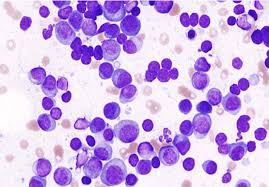 Refers to the tissue in the interior of bones.
Refers to the tissue in the interior of bones.
Blood cells are produced by cores of bone marrow in the heads of long bones in a process known as hematopoiesis.
Constitutes about 4% of the total body mass.
In an adult having 65 kilograms of mass (143 lbs), bone marrow typically accounts for approximately 2.6 kilograms (5.7 lb).
The bone marrow produces approximately 500 billion blood cells per day.
The hematopoietic component of bone marrow uses the bone marrow vasculature as a conduit to the body’s systemic circulation.
It is a major component of the lymphatic system, as it produces the lymphocytes that support the body’s immune system.
Bone marrow transplants can treat severe diseases of the bone marrow, including certain forms of cancer such as leukemia and myeloma.
Bone marrow stem cells can be transformed into multi potential cells.
Bone marrow is made up of red marrow, which consists mainly of hematopoietic tissue, and yellow marrow, which is mainly made up of fat cells.
Red blood cells, platelets, and most white blood cells are formed in red marrow.
Both types of bone marrow contain numerous blood vessels and capillaries.
At birth, all bone marrow is red.
With age, more of it is converted to the yellow type of marrow.
Only around half of adult bone marrow is red.
Red marrow is found mainly in the flat bones, such as the pelvis, sternum, cranium, ribs, vertebrae and scapulae, and in the cancellous material at the epiphyseal ends of long bones such as the femur and humerus.
Yellow marrow is found in the medullary cavity.
Under distress of severe blood loss, the body can convert yellow marrow back to red marrow to increase blood cell production.
The one marrow stroma refers to all tissue not directly involved in the marrow’s primary function of hematopoiesis.
Yellow bone marrow makes up the majority of bone marrow stroma, in addition to smaller numbers of stromal cells located in the red bone marrow.
Stroma is indirectly involved in hematopoiesis, providing the hematopoietic microenvironment that facilitates hematopoiesis by the parenchymal cells.
Stroma generates colony stimulating factors, which have a significant effect on hematopoiesis.
Cell types that constitute the bone marrow stroma include:
fibroblasts
macrophages (they deliver iron for hemoglobin production)
osteoblasts
osteoclasts
Myelopoietic cells
Myeloblasts 0.9% 0.2-1.5
Promyelocytes 3.3% 2.1-4.1
Neutrophilic myelocytes 12.7% 8.2-15.7
Eosinophilic myelocytes 0.8% 0.2-1.3
Neutrophilic metamyelocytes 15.9% 9.6-24.6
Eosinophilic metamyelocytes 1.2% 0.4-2.2
Neutrophilic band cells 12.4% 9.5-15.3
Eosinophilic band cells 0.9% 0.2-2.4
Segmented neutrophils 7.4% 6.0-12.0
Segmented eosinophils 0.5% 0.0-1.3
Segmented basophils and mast cells 0.1% 0.0-0.2
Erythropoietic cells
Pronormoblasts 0.6% 0.2-1.3
Basophilic normoblasts 1.4% 0.5-2.4
Polychromatic normoblasts 21.6% 17.9-29.2
Orthochromatic normoblast 2.0% 0.4-4.6
Other cell types
Megakaryocytes < 0.1% 0.0-0.4
Plasma cells 1.3% 0.4-3.9
Reticular cells 0.3% 0.0-0.9
Lymphocytes 16.2% 11.1-23.2
Monocytes 0.3% 0.0-0.8
The bone marrow contains hematopoietic stem cells, which give rise to the three classes of blood cells that are found in the circulation: leukocytes, erythrocytes, and platelets.
The bone marrow stroma contains mesenchymal stem cells, also known as marrow stromal cells, that are multipotent stem cells that can differentiate into a variety of cell types.
Mesenchymal stem cells can differentiate into osteoblasts, chondrocytes, myocytes, adipocytes and beta-pancreatic islets cells.
The blood vessels of the bone marrow inhibit immature blood cells from leaving the marrow.
Mature blood cells that contain the membrane proteins, such as aquaporin and glycophorin, that required attach to and pass the blood vessel endothelium.
Hematopoietic stem cells can cross the bone marrow barrier, and be harvested from blood.
The bone marrow is one of the primary lymphoid organs that generate lymphocytes from immature hematopoietic progenitor cells, and with the thymus constitutes the primary lymphoid tissues involved in the production and early selection of lymphocytes.
The bone marrow prevents the backflow of lymphatic fluid in the lymphatic system.
Erythrocytes, macrophages, and their precursors tend to aggregate around blood vessels, while granulocytes gather at the borders of the bone marrow.
Bone marrow architecture can be damaged or displaced by aplastic anemia, malignancies, fibrosis or infections which can lead to a decrease in the production of blood cells.
Exposure to radiation or chemotherapy will impair dividing cells of the bone marrow, and will therefore result in a depressed immune system and lowered blood counts.
To diagnose diseases involving the bone marrow, a bone marrow aspiration and biopsy can be performed.
On CT and plain film, marrow change can be seen indirectly by changes inkthe adjacent ossified bone.
MRI is usually more sensitive and specific for bone marrow pathology, particularly for hematologic malignancies like leukemia and lymphoma.
Bone marrow changes are difficult to distinguish from the red marrow hyperplasia of hematopoiesis
Fatty marrow change, can occur with normal aging and with certain treatments such as radiation therapy.
Diffuse marrow T1 hypointensity without contrast enhancement or cortical discontinuity suggests myelofibrosis.
Falsely normal marrow on T1 can be seen with multiple myeloma or leukemic infiltration.
Bone marrow examination is obtained via biopsy and bone marrow aspiration.
Bone marrow examination is used in the diagnosis of: leukemia, multiple myeloma, anemia, and pancytopenia.
The bone marrow produces the cellular elements of the blood, including platelets, red blood cells and white blood cells.
Bone marrow provides information on hematopoiesis.
The ratio between myeloid series and erythroid cells provides I formation about bone marrow function, and diseases of the bone marrow and peripheral blood, such as leukemia and anemia.
The normal myeloid-to-erythroid ratio is around 3:1.
The normal myeloid-to-erythroid ratio may increase in myelogenous leukemias, decrease in polycythemias, and reverse in cases of thalassemia.
In adults, bone marrow may also be taken from the sternum, while the tibia is often used when taking samples from infants.
In newborns, stem cells may be retrieved from the umbilical cord.
